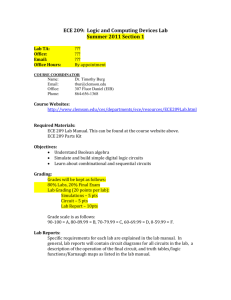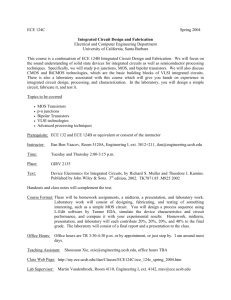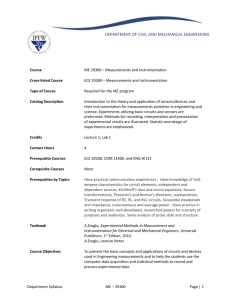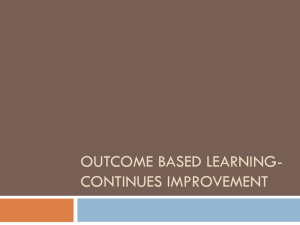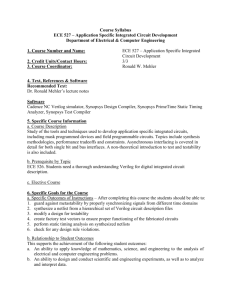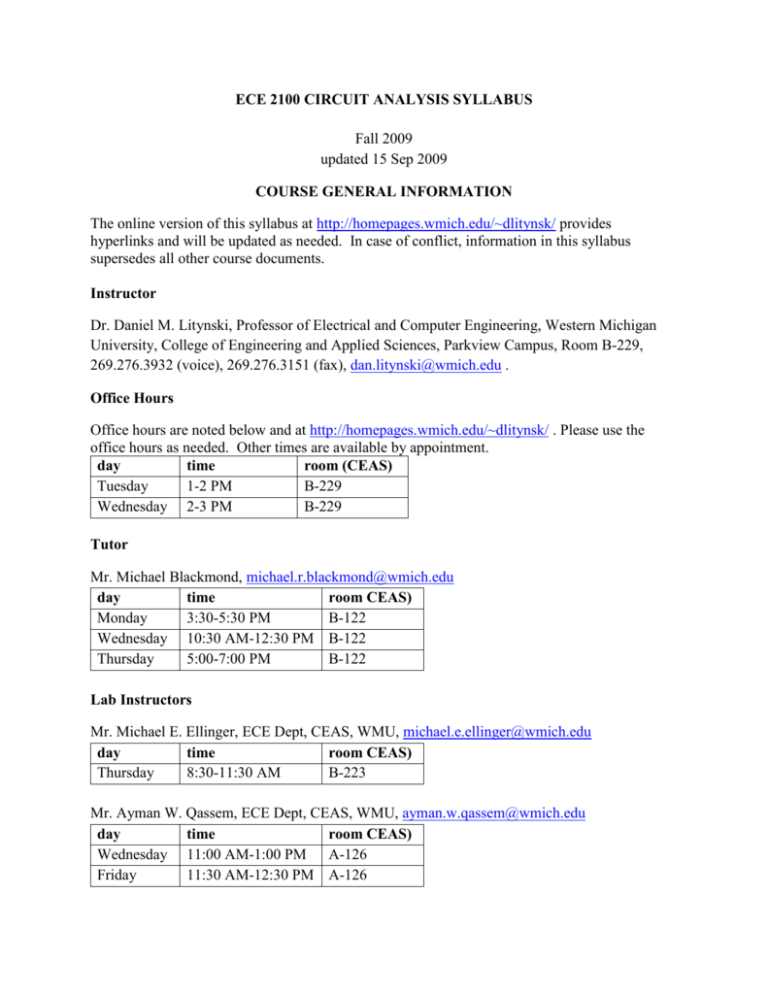
ECE 2100 CIRCUIT ANALYSIS SYLLABUS
Fall 2009
updated 15 Sep 2009
COURSE GENERAL INFORMATION
The online version of this syllabus at http://homepages.wmich.edu/~dlitynsk/ provides
hyperlinks and will be updated as needed. In case of conflict, information in this syllabus
supersedes all other course documents.
Instructor
Dr. Daniel M. Litynski, Professor of Electrical and Computer Engineering, Western Michigan
University, College of Engineering and Applied Sciences, Parkview Campus, Room B-229,
269.276.3932 (voice), 269.276.3151 (fax), dan.litynski@wmich.edu .
Office Hours
Office hours are noted below and at http://homepages.wmich.edu/~dlitynsk/ . Please use the
office hours as needed. Other times are available by appointment.
day
time
room (CEAS)
Tuesday
1-2 PM
B-229
Wednesday 2-3 PM
B-229
Tutor
Mr. Michael Blackmond, michael.r.blackmond@wmich.edu
day
time
room CEAS)
Monday
3:30-5:30 PM
B-122
Wednesday 10:30 AM-12:30 PM B-122
Thursday
5:00-7:00 PM
B-122
Lab Instructors
Mr. Michael E. Ellinger, ECE Dept, CEAS, WMU, michael.e.ellinger@wmich.edu
day
time
room CEAS)
Thursday
8:30-11:30 AM
B-223
Mr. Ayman W. Qassem, ECE Dept, CEAS, WMU, ayman.w.qassem@wmich.edu
day
time
room CEAS)
Wednesday 11:00 AM-1:00 PM A-126
Friday
11:30 AM-12:30 PM A-126
ECE 2100 CIRCUIT ANALYSIS SYLLABUS: Fall 2009
WMU Catalog Description
ECE 2100 Circuit Analysis. Analysis of linear electric circuits using methods based on
Kirchhoff's laws and network theorems. RL, RC, and RLC transients. Sinusoidal steady state
analysis. Prerequisites & Corequisites: Prerequisites: PHYS 2070 or taken concurrently and
MATH 1230 or 1710. Credits: 4 hours. Lecture Hours - Laboratory Hours: (3 - 3)
ECE 2100 Course Learning Outcomes
This course develops:
1. an understanding of electric charge, current, voltage, energy, and power;
2. an ability to analyze linear DC circuits using Ohm's law, Kirchhoff's voltage law (mesh
analysis), and Kirchhoff's current law (nodal analysis);
3. an ability to utilize network analysis techniques including superposition, source
transformations, and Thevenin and Norton's theorems;
4. an ability to design simple DC voltmeters and ammeters using d'Arsonval movement
meters;
5. an ability to analyze and design electronic circuits that utilize operational amplifiers;
6. an understanding of the terminal characteristics of capacitors and inductors;
7. an ability to analyze steady state linear AC circuits containing dependent and independent
sources, resistors, capacitors, and inductors;
8. an ability to perform DC and AC power calculations including power factor correction;
9. an ability to represent the total system response as a sum of a transient and steady state
response and a natural and forced response;
10. an ability to determine the step response of first and second order linear circuits;
11. an ability to analyze, simulate, and experimentally validate DC and AC circuits;
12. an ability to use electronic test instrumentation such as voltmeters, ammeters, ohmmeters,
signal generators, oscilloscopes, and wattmeters;
13. an ability to prepare effective written technical communications for engineering analysis
work;
14. an ability to thoroughly and accurately document laboratory work using a laboratory
notebook;
15. an ability to function as an effective engineering team member; and
16. a recognition of the need for life-long learning.
Textbook and Materials (lecture)
Required:
1. C. K. Alexander and M. N. O. Sadiku, Fundamentals of Electric Circuits, 4th ed.,
McGraw-Hill, Boston, 2009 (ISBN 0-07-352955-9). Available in bookstore.
2. McGraw-Hill ARISTM Access Code to Accompany Alexander Fundamentals of Electric
Circuits (ISBN 0-07-7251601). You must ask for this AT BOOK INFORMATION in
the bookstore.
© 2009 Damon A. Miller and Daniel M. Litynski. All rights reserved.
Updated 15 Sep 09
Page 2 of 11
ECE 2100 CIRCUIT ANALYSIS SYLLABUS: Fall 2009
Reference:
1. J. W. Nilsson and S. A. Riedel, Electric Circuits, 8th ed., Pearson Prentice Hall, Upper
Saddle River, New Jersey, 2008 (ISBN 0-13-198925-1). Some problems in lecture are
from this text.
2. W. H. Hayt, Jr., S. Durbin, and J. E. Kemmerly, Engineering Circuit Analysis, McGrawHill, Boston, 7/e, 2007. Some online homework problems are from this text.
Recommended:
1. The Rose-Hulman Institute of Technology has an excellent interactive “Circuits Learned
by Example Online” website that includes mini-lectures on how to work many types of
circuit analysis problems: http://www.rose-hulman.edu/CLEO/
2. http://www.allaboutcircuits.com/
3. http://falstad.com/circuit/
4. A high level mathematics software suite is useful but not required for course assignments.
The main motivation for recommending a mathematics software suite is to develop your
capabilities in using such a package. Pick one and master it for use throughout your
academic and professional career.
a. The MathWorks MATLAB® & SIMULINK® is one of the most widely used software
packages, especially in electrical engineering. The CAE center provides access to this
software. You may want to use this opportunity to learn MATLAB®.
b. Wolfram Research, Mathematica® is a remarkable, unified, symbolic approach to
computing. Visit http://www.mathematica.com/ to see some of the extraordinary
capabilities of this package developed by Stephen Wolfram.
c. MapleSoft, Maple®, is available on main campus.
d. These may also be found at the WMU bookstore or www.academicsuperstore.com.
Textbook and Materials (laboratory)
Required:
1. J. Kelemen, D. A. Miller, F. L. Severance, et al., ECE 2100 Laboratory Manual. Go to
the online version of this syllabus at http://homepages.wmich.edu/~dlitynsk/ to obtain
this manual. It is your responsibility to check for updates as the semester progresses.
2. Digital multimeter, available from IEEE student branch. Assistance with operation of
other multimeter models other than those sold by the IEEE will not be provided.
3. Linear Technology, LTspice/SwitcherCADTM III, available at no cost at
http://www.linear.com/designtools/software/. This software will be used to simulate
circuits and is available in the CAE center and in the ECE 2100 laboratory. You are
responsible for ensuring access to a working copy.
© 2009 Damon A. Miller and Daniel M. Litynski. All rights reserved.
Updated 15 Sep 09
Page 3 of 11
ECE 2100 CIRCUIT ANALYSIS SYLLABUS: Fall 2009
4.
5.
6.
7.
8.
9.
SPICE EXAMPLES
a. VCCS example (problem 4.43 from Nilsson and Reidel Electric Circuits 8th ed.)
b. CCCS and CCVS example (problem 4.51 from Nilsson and Reidel Electric Circuits
8th ed.)
c. VCVS example (simple operational amplifier model)
d. Chua’s “Simple” Chaotic Circuit (need the National Semiconductor LM741 model
available as part of laboratory six in the course schedule below)
Laboratory notebook, permanently bound, not loose leaf, 8.5 inches x 11 inches, 60 pages
minimum, quadrille ruled (each page has a square grid), no carbon paper pages.
Ruler
Calculator
Pen
Bring course textbook to lab.
Safety goggles. Students will not be admitted to the lab without safety goggles.
COURSE POLICIES
Academic Honesty
General:
“You are responsible for making yourself aware of and understanding the policies and
procedures in the Undergraduate and Graduate Catalogs that pertain to Academic
Honesty. These policies include cheating, fabrication, falsification and forgery, multiple
submission, plagiarism, complicity and computer misuse. [The policies can be found at
http://catalog.wmich.edu under Academic Policies, Student Rights and Responsibilities.]
If there is reason to believe you have been involved in academic dishonesty, you will be
referred to the Office of Student Conduct. You will be given the opportunity to review the
charge(s). If you believe you are not responsible, you will have the opportunity for a
hearing. You should consult with your instructor if you are uncertain about an issue of
academic honesty prior to the submission of an assignment or test.” — provided by the
Professional Concerns Committee of the WMU Faculty Senate
Plagiarism:
“One of the most serious academic offenses is plagiarism (see definition for "plagiarize"
in the Cambridge Advanced Learner's Dictionary). If your institution, colleagues, or
professional organization believe that you have unfairly used the work (the intellectual
property) of another person, you may lose your job, be asked to leave your university,
and/or have your professional career ruined” [from
www.ohiou.edu/Esl/help/plagiarism.html]. See that website for tutorials on how to insure
that you never plagiarize another’s work.
© 2009 Damon A. Miller and Daniel M. Litynski. All rights reserved.
Updated 15 Sep 09
Page 4 of 11
ECE 2100 CIRCUIT ANALYSIS SYLLABUS: Fall 2009
COURSE GRADING
General
1. Examinations (2 or more plus final): 70%
2. Homework and Quizzes (announced or unannounced): 10%
3. Laboratory: 20%
You must earn at least a “C” in the laboratory to pass ECE 2100.
OUTSTANDING WORK might earn extra credit. The first student to report an error in any
material prepared in the course will earn extra credit.
Scale: 0-50 E | 50-55 D | 55-60 DC | 60-65 C | 65-70 CB | 70-75 B | 75-80 BA | 80-100 A |
Examinations and Quizzes will be closed-notes closed-book unless otherwise noted. You must
have a WMU issued ID with you at the exam.
Only under extremely unusual circumstances will make-up examinations and quizzes be
considered. If an emergency prevents you from attending a scheduled examination or quiz,
contact your instructor PRIOR to the test or as soon as you can reach a telephone, e-mail
terminal, etc. If the instructor cannot be reached directly, leave a message with the department
(276-3150). Failure to adhere to this policy will result in zero credit for the exercise.
Use of Calculators
When a calculator is allowed on a quiz/exam, without exception only models accepted by the
Fundamentals of Engineering Examination may be used; for a list of approved calculators see
http://www.ncees.org/exams/calculators/index.php#approved.
Homework
There are two types of homework assignments: homework submitted in-class and homework
submitted on-line. One or both types might be assigned. ALL homework assignments will be
announced in class.
For In-Class Submissions
Students must maintain a homework folder that is brought to each class. Assignments will be
randomly collected from the homework folder perhaps without prior warning. Homework due
dates will be given in class. Homework is due at the beginning of lecture. Each homework
problem must be worked on separate page(s). LATE HOMEWORK will not be accepted, except
under extraordinary circumstances. Homework is to be completed individually.
Homework should normally be done on 8 1/2'' by 11'' sheets. “Engineer's Pad” sheets are
preferred. Solutions must be done in a neat, structured, logical, and orderly manner with
frequent brief notations enabling the grader to readily verify the author's source of information,
© 2009 Damon A. Miller and Daniel M. Litynski. All rights reserved.
Updated 15 Sep 09
Page 5 of 11
ECE 2100 CIRCUIT ANALYSIS SYLLABUS: Fall 2009
steps taken, sources of formula, equations, and methods used. USE THE PARTIAL CHECK
LIST FOR SUBMITTED HOMEWORK BELOW. Papers failing to meet these guidelines may
not be graded and may be returned, with or without an opportunity for resubmission with a
penalty.
PARTIAL CHECK LIST FOR SUBMITTED HOMEWORK
1. Each problem must include: (a) author's name, (b) name/title of the assignment, and (c)
date of completion. PUT YOUR LABORATORY MEETING DAY AND TIME IN
THE UPPER RIGHT HAND CORNER.
2. Use only one side of the paper and include a brief and concise statement of the problem
prior to its solution. Begin each problem on a new page.
3. Number the pages and DOUBLE SPACE the text.
4. Staple each problem in the upper left corner as needed.
5. Entitle graphs, label and include axes, include key symbols for multiple curve graphs, and
give brief notes of explanation where appropriate.
6. Briefly but clearly annotate your document in a way which will provide the document
reader with information such as
a. which part of the assignment is this?
b. what is being done and why?
c. how was it done and what are the results?
d. how was this equation obtained and how was it used?
e. sample calculations and definitions of symbols/parameters where appropriate; and
f. BOX AND LABEL ANSWERS.
For On-Line Submissions
The on-line homework process will be discussed in class. Consult these registration instructions
to setup your account after you have purchased your ARISTM access code.
It is your responsibility to monitor your online homework grades to insure that you have received
proper credit. Be sure to email the course instructor with any pseudonym you use when
registering for the on-line homework system.
If you believe that there is an error in an online problem solution, submit that problem to the
instructor before the assignment due date either in class or in the instructor’s mail box in the
ECE Department. Include complete documentation (e.g. circuit diagrams) and a printout of the
online solution with error(s) identified. Clearly show how you arrived at your solution. Follow
the “in-class” submissions homework guidelines.
browser settings for ARISTM (provided by Cassandra Loskot of McGraw-Hill Higher
Education)(some names in are registered trademarks, e.g. Internet Explorer®)
© 2009 Damon A. Miller and Daniel M. Litynski. All rights reserved.
Updated 15 Sep 09
Page 6 of 11
ECE 2100 CIRCUIT ANALYSIS SYLLABUS: Fall 2009
LABORATORY
Lab attendance is mandatory. Only under extremely unusual circumstances will make-up
laboratories be considered. Religious observances will be accommodated with advanced notice.
If an emergency prevents you from attending a laboratory, contact your instructor PRIOR to the
lab or as soon as you can reach a telephone, e-mail terminal, etc. If the instructor cannot be
reached directly, leave a message with the department (276-3150). Failure to adhere to this
policy will result in zero credit for the lab and any other activities (e.g. quizzes) conducted in lab
on the day of the absence.
While experimental data is collected in groups, all other laboratory activities must be completed
individually. Additional laboratory requirements will be presented in the first laboratory
meeting.
Grading Basis
Your laboratory grade will be determined using the following evaluation criteria:
1. Laboratory technique including demonstration of an ability to make appropriate
observations and accurately and satisfactorily record observations and data in writing in a
laboratory notebook (50%). Lab notebooks provide a convenient and professional method
of organizing and storing your lab work and records. Your laboratory notebook will be
evaluated several times during the semester for neatness, organization, technical
accuracy, and completeness. Specific guidelines for the notebook will be provided in the
laboratory. Unless otherwise indicated, pre-lab assignments must be completed in your
lab notebook before coming to lab. Each laboratory must be initialed by the lab
instructor. Signatures will be made in only two cases:
a. the laboratory is complete including the results section (LAB COMPLETE
signature);
b. the lab session is over (IN PROGRESS signature). For this case a second LAB
COMPLETE signature is required by the end of the next lab session.
2. Pre-lab quizzes (30%). Quizzes are closed book; however, you may use your laboratory
notebook on quizzes. Sources of quiz questions include previous labs and the current
week’s pre-lab assignment and may require calculations.
3. Laboratory report(s) (20%). Report(s) will be assigned in lecture and (as with homework)
are due at the beginning of lecture.
Failure to follow safe laboratory procedures as described in lab will result in failure in the
course.
You must earn at least a “C” in the laboratory to pass ECE 2100.
© 2009 Damon A. Miller and Daniel M. Litynski. All rights reserved.
Updated 15 Sep 09
Page 7 of 11
ECE 2100 CIRCUIT ANALYSIS SYLLABUS: Fall 2009
COURSE SCHEDULE
(a tentative schedule for the semester was provided in class; the online schedule will be
frequently updated as the semester progresses)
class
date
#
WEEK 1
NO LAB
1
9 Sep
topic
assignments
review syllabus
overview of electrical engineering
What is an electric circuit?
introduction to ARISTM system
read syllabus and lab #1
documents
read CH 1, 2
HW #1: TEXT: CH 1:
DUE Wed 16 Sep: 0930
AM 1,2a,2d,3b,4,6,11,14
2
11 Sep
electric charge and current
voltage
power and energy
passive sign convention
circuit elements
WEEK 2
LAB 1: Basic Circuit Measurements and Ohm’s Law
ECE 2100 Laboratory: Safety and Rules
ECE 2100 Laboratory: Notebook Requirements
Ohm’s law
3
14 Sep
network topology: nodes, branches, and
loops
4
16 Sep
Kirchhoff’s current and voltage laws
series resistors/voltage dividers
5
18 Sep
parallel resistors/current dividers
WEEK 3
LAB 2: Series and Parallel Circuits
design of a voltmeter and ammeter using
analog meters
6
21 Sep
7
23 Sep
nodal analysis
8
25 Sep
nodal analysis
WEEK 4
LAB 3: Basic DC Meter Design
9
28 Sep
mesh analysis
mesh analysis
10
30 Sep
HW #2: Fundamentals:
ARISTM: DUE Mon 21 Sep
11PM: 8 problems
read CH 3 and Appendix A
HW #3: Nodal Analysis:
ARISTM: DUE Mon 28 Sep
11PM: 3 problems
NOTE: #3 has error in
solution
HW #4: Mesh Analysis:
ARISTM: DUE Mon 5 Oct
© 2009 Damon A. Miller and Daniel M. Litynski. All rights reserved.
Updated 15 Sep 09
Page 8 of 11
ECE 2100 CIRCUIT ANALYSIS SYLLABUS: Fall 2009
“nodal and mesh analysis by inspection”
11
11PM: 4 problems
NOTE: #1 has error in
solution
(title of text section 3.6)
2 Oct
read CH 4
WEEK 5
LAB 4: Nodal and Mesh Analysis: Comparison of Analysis, Experimental, and Simulated
(SPICE) Results
linear systems
12
5 Oct
superposition principle
source transformations
13
7 Oct
source transformations
Thevenin’s theorem
HW #5: ARISTM: Network
14
9 Oct
Theorems: DUE Fri 16 Oct
11PM: 5 problems
WEEK 6
LAB 5: Superposition and Thevenin’s Theorem
negative resistance
Norton’s theorem
Read CH 5
15
12 Oct
maximum power transfer theorem
Wheatstone bridge
operational amplifiers: ideal model
operational amplifiers: example circuits:
16
14 Oct
inverting, non-inverting, buffer amplifiers
operational amplifiers: difference
17
16 Oct
amplifier
WEEK 7
LAB 6: Operational Amplifier Circuits
NationalSemiconductorModels.lib (contains model of LM741 from National Semiconductor)
EXAM 1 (CH 1-4 and related labs)
no calculators, bring WMU ID
18
19 Oct
19
21 Oct
20
23 Oct
sample ECE 2100 exam #1
NOTE: for practice only; your exam
might not look anything like this one!
operational amplifiers: instrumentation
amplifiers and cascaded operational
amplifier circuits
capacitance
ultracapacitors
assign lab report #A – Lab number to be
turned in will be announced
(must be completed individually)
laboratory report guidelines
Read CH 6
HW #6: ARISTM :
Operational Amplifiers,
Capacitance, and
Inductance: DUE Mon 2
Nov 11PM: 7 problems
HW #7: text: DUE Mon 9
© 2009 Damon A. Miller and Daniel M. Litynski. All rights reserved.
Updated 15 Sep 09
Page 9 of 11
ECE 2100 CIRCUIT ANALYSIS SYLLABUS: Fall 2009
Nov: CH 6: 1,5,13,26,34,
46,51,61,67
WEEK 8
LAB 7: Basic Waveforms and Oscilloscope Operation
electronic integrators/differentiators
21
26 Oct
inductance
22
28 Oct
inductance
23
30 Oct
introduction to sinusoids and phasors
WEEK 9
NO LAB
passive circuit elements in the phasor
24
2 Nov
domain
passive circuit elements in the phasor
25
4 Nov
domain
series RLC circuit
26
6 Nov
RC low pass filter
WEEK 10
LAB 8: Steady-State AC Behavior of Passive Circuit Elements
LAST DAY TO WITHDRAW FROM
FALL COURSES
27
9 Nov
impedance and admittance
circuit theorems in the phasor domain
circuit theorems in the phasor domain
What is RMS?
28
11 Nov
instantaneous and average power
read CH 9 and Appendix B
read CH 10
lab report #1 due
read CH 11
HW #8: ARISTM : Phasors
and Steady State Analysis:
DUE Fri 20 Nov 11PM: 10
problems
maximum power transfer
measuring AC power
29
13 Nov
assign lab report #B - Lab number to be
turned in will be announced
(must be completed individually
WEEK 11
LAB 9: Frequency and Intuitive Step Response of RC Filters
(laboratory team self-assessment form will be provided by the laboratory instructor)
power factor
30
16 Nov
complex power
power triangle
read CH 7
31
18 Nov
power factor correction
intro to first order circuits
32
20 Nov
natural response (RC)
natural response (RL)
WEEK 12
NO LAB: Thanksgiving Week
singularity functions
33
23 Nov
step response (RC)
© 2009 Damon A. Miller and Daniel M. Litynski. All rights reserved.
Updated 15 Sep 09
Page 10 of 11
ECE 2100 CIRCUIT ANALYSIS SYLLABUS: Fall 2009
34
25 Nov
step response (RL)
first order circuits: general solution
sequential switching
first order unbounded response via
negative resistance
read CH 8
Thanksgiving Recess begins at noon
WEEK 13
LAB 10: AC Power and Power Factor Correction
(laboratory team self-assessment form will be provided by the laboratory instructor)
35
30 Nov
second order circuits
second order circuits
HW #9: ARISTM : First
and Second Order Circuits:
36
2 Dec
DUE Wed 9 Dec 11 PM:
5 problems
37
4 Dec
second order circuits
WEEK 14
LAB 11: Step Response of a RC Circuit
LAB 12: Step Response of a RLC Circuit
(lab notebooks must be graded and returned by Friday 11 Dec 09
EXAM 2
approved calculators only, bring WMU ID
covers all material except CH 7 and 8
38
7 Dec
39
9 Dec
40
11 Dec
sample ECE 2100 exam #2
NOTE: for practice only; your exam
might not look anything like this one!
second order circuits: step response
return laboratory notebooks
review sample finals
course wrap-up
instructor evaluation
lab report #2 due
WEEK 15
FINAL EXAM
approved calculators only, bring WMU ID
41
15 Dec
sample ECE 2100 final exam
NOTE: for practice only; your exam
might not look anything like this one!
Credits and Copyright
Adapted substantially from syllabi by D. Miller, J. Gesink, and J. Kelemen. Some material is
verbatim from an ECE 2100 Laboratory Manual developed by former and current ECE faculty.
Return to Dr. Litynski homepage
© 2009 Damon A. Miller and Daniel M. Litynski. All rights reserved.
Updated 15 Sep 09
Page 11 of 11

